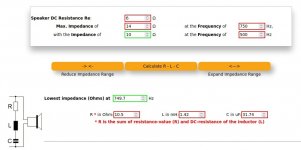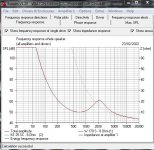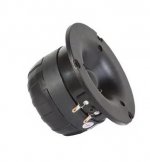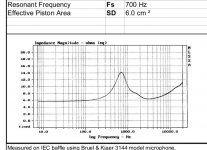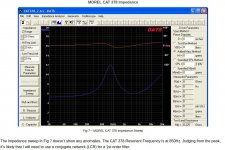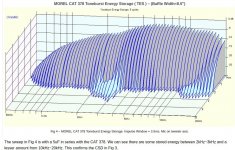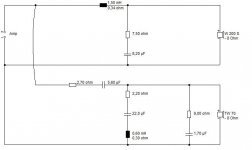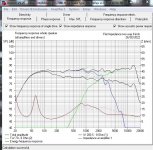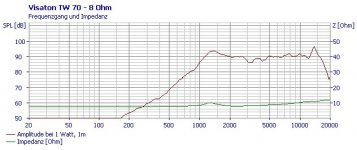Not quite. I think you have about 7 more years to make that mark. I believe I first heard it in 2007, and it had been out a year or 2.The old Peerless HDS (now Scanspeak D2608/9130) is still around: Isn't it 20 years old by now?
Well, yea, fred......
You play bass guitar, and crank drum music !!!!! Lol
Like djk said, unless there are a pair of 12's a side (3-way), it ain't gunna cut it (volume levels, dynamics).
You play bass guitar, and crank drum music !!!!! Lol
Like djk said, unless there are a pair of 12's a side (3-way), it ain't gunna cut it (volume levels, dynamics).
Im using some of those Wavecore TW030WA11's with some Dayton RS180-4, they are crossed 3rd order at 1650Hz. The 11's are the wave guide model.
They dont sound too bad at higher volume levels near 100db(guesstimated)the higher mid sounds very smooth and the highs not overbearing, I needed the lower xover point to keep away from the nasty cone break up of the rs180s on my boombox project and I was hoping the waveguide would help with my weird baffle shape by allowing a nice smooth transition to the baffle.
I havent had then on a decent amp yet, Im only getting maybe 50w from a Dayton DTA2.1 amp but its actually quite loud... as loud as my car system which also has large dia tweeters/6.5"mids(Higher end Pioneer splits)12"sealed sub fed 120wrms from an nice Alpine 5ch amp(bridged into 3ch)all in a single cab ute!
They dont sound too bad at higher volume levels near 100db(guesstimated)the higher mid sounds very smooth and the highs not overbearing, I needed the lower xover point to keep away from the nasty cone break up of the rs180s on my boombox project and I was hoping the waveguide would help with my weird baffle shape by allowing a nice smooth transition to the baffle.
I havent had then on a decent amp yet, Im only getting maybe 50w from a Dayton DTA2.1 amp but its actually quite loud... as loud as my car system which also has large dia tweeters/6.5"mids(Higher end Pioneer splits)12"sealed sub fed 120wrms from an nice Alpine 5ch amp(bridged into 3ch)all in a single cab ute!
This might interest the 1st order fanatics. How to equalise the tweeter Fs impedance bump on the CAT378 or similar. What is called an LCR conjugate.
https://www.diyaudio.com/community/threads/seas-a26-devore-style-build.369124/page-2#post-6573112
I used this online calculator with values lifted from the CAT378 FR and impedance curves.
http://www.mh-audio.nl/Calculators/ICTAPX.html
Very impressively accurate. Almost exactly what Mike Chua got in the Finch. I enclose the source impedance seen by the tweeter with (solid) and without the conjugate (dotted) acting around 750Hz.
This stops the tweeter excursion getting out of hand by increasing electrical damping.
https://www.diyaudio.com/community/threads/seas-a26-devore-style-build.369124/page-2#post-6573112
I used this online calculator with values lifted from the CAT378 FR and impedance curves.
http://www.mh-audio.nl/Calculators/ICTAPX.html
Very impressively accurate. Almost exactly what Mike Chua got in the Finch. I enclose the source impedance seen by the tweeter with (solid) and without the conjugate (dotted) acting around 750Hz.
This stops the tweeter excursion getting out of hand by increasing electrical damping.
Attachments
Close, but no cigar. The tweeter is unaffected. All you are doing is changing the impedance vs frequency seen by the "crossover" (a single capacitor) that operates into the tweeter+conjugate_LCR network. This DOES have the intended effect of reducing/eliminating the attenuation rebound that happens around the tweeter's impedance peak at resonance, but there is no effect on "damping" of the tweeter's response.This stops the tweeter excursion getting out of hand by increasing electrical damping.
The tweeter is not unaffected, it ’sees’ the impedance of the conjugate network, which is not infinite at all. So electrical damping will be present.
I'm not sure I understand your logic. The way the circuit is drawn above the LCR is in parallel with the tweeter to give the overall network. The input to this network will be connected to an amplifier and assuming a solid state amplifier it will have a zero output impedance. So as seen by the tweeter there is a zero impedance source in parallel with the impedance of the LCR network, which would change nothing as far as the tweeter is concerned IIUC. FWIW, this would not be the case with other types of circuits in which there are elements in series with the tweeter.The tweeter is not unaffected, it ’sees’ the impedance of the conjugate network, which is not infinite at all. So electrical damping will be present.
Are we clear whether the response changes in this case as that would make a difference. Normally I'd assume it hasn't for the true purpose of this conversation but currently it's ambiguous.
This might interest the 1st order fanatics. How to equalise the tweeter Fs impedance bump on the CAT378 or similar. What is called an LCR conjugate.
https://www.diyaudio.com/community/threads/seas-a26-devore-style-build.369124/page-2#post-6573112
I used this online calculator with values lifted from the CAT378 FR and impedance curves.
http://www.mh-audio.nl/Calculators/ICTAPX.html
Very impressively accurate. Almost exactly what Mike Chua got in the Finch. I enclose the source impedance seen by the tweeter with (solid) and without the conjugate (dotted) acting around 750Hz.
This stops the tweeter excursion getting out of hand by increasing electrical damping.
Science is definitely your thing, not horse betting ! 😉
Why? Is it for the sake of simple trial and error and because you dont have the necessary measurement gear?Any tweeters out there that are will handle a 1st order acoustic crossover@2500Hz (or so) for reasonable levels (100 db)?
Not counting super expensive Bliesma T34 😱
Maybe Wavecor TW030WA11/12?
Or SB29RDNC?
Quite a few of the popular well-liked brands through the years (AR, Marantz, etc) used the same phenolic-ring tweeter, available on Parts Express and other sites.
I've used them in new builds and always had good results.
They're good down to 2Khz.
https://www.parts-express.com/GRS-PRT-8-Phenolic-Ring-Tweeter-8-Ohm-270-252
I've used them in new builds and always had good results.
They're good down to 2Khz.
https://www.parts-express.com/GRS-PRT-8-Phenolic-Ring-Tweeter-8-Ohm-270-252
Thinking theoretically........................
i agree with charlie, just because you have a parallel circuit that has less Z at the tweeter's Fs, the amplifier will just supply more overall current. To the amplifier, Total Z will be lower, then current will be higher.
The current through the tweeter at its Fs will be the same as it was b4, meaning same excursion.
i agree with charlie, just because you have a parallel circuit that has less Z at the tweeter's Fs, the amplifier will just supply more overall current. To the amplifier, Total Z will be lower, then current will be higher.
The current through the tweeter at its Fs will be the same as it was b4, meaning same excursion.
As usual, many sub-topics need addressing here unless we slide into the usual confusion. Cone tweeters, soft-dome tweeters, semi-horn loading, low order crossovers. 😀
Let's start with the infamous ferrofluid Morel CAT378. What do we know?
Looks alright to me. Much as I hate soft-domes. As an Engineer, I must do my best with it.
As wolf_teeth says, it has significant production variations. 😕
Morel say the Fs resonance is at 700Hz. Mike Chua measured it and got 850Hz. Q varies. Rdc seems constant at 5.2R.
My money is always on the Waterfall. Which is about worrisome Stored Energy. Bit of a mess with a simple capacitor. But I know how to fix that. An LCR conjugate.
Let's start with the infamous ferrofluid Morel CAT378. What do we know?
Looks alright to me. Much as I hate soft-domes. As an Engineer, I must do my best with it.
As wolf_teeth says, it has significant production variations. 😕
Morel say the Fs resonance is at 700Hz. Mike Chua measured it and got 850Hz. Q varies. Rdc seems constant at 5.2R.
My money is always on the Waterfall. Which is about worrisome Stored Energy. Bit of a mess with a simple capacitor. But I know how to fix that. An LCR conjugate.
Attachments
The Dayton RST28F sounds the same if not better than the Morel
Half the price
Resonant Frequency is also in the 700Hz range
supports simple 1st order no problem.
Otherwise for even less money
HiVi has a few Planars that can go down to 2500/3000
And sound even better than soft domes.
Half the price
Resonant Frequency is also in the 700Hz range
supports simple 1st order no problem.
Otherwise for even less money
HiVi has a few Planars that can go down to 2500/3000
And sound even better than soft domes.
The point is that there is a cap somewhere too. Or were we talking active X-overs?I'm not sure I understand your logic. The way the circuit is drawn above the LCR is in parallel with the tweeter to give the overall network. The input to this network will be connected to an amplifier and assuming a solid state amplifier it will have a zero output impedance. So as seen by the tweeter there is a zero impedance source in parallel with the impedance of the LCR network, which would change nothing as far as the tweeter is concerned IIUC. FWIW, this would not be the case with other types of circuits in which there are elements in series with the tweeter.
@ norman bates. Yes, Dayton RST28F looks doable. But a flat plate tweeter is less suitable to single capacitor crossover than horn-loaded, IMO.
https://audioxpress.com/article/tes...s-from-dayton-audio-rst28a-4-and-the-rst28f-4
I'd fit a calculated conjugate anyway:
http://www.mh-audio.nl/Calculators/ICTAPX.html
@ wiseoldtech. Here is how I would do the Visaton TW70 cone tweeter these days. Not exactly a conjugate, more an LCR notch. But all falls into place with a single capacitor, which I suppose is 6dB electrical.
I think I have all the bits lying around, so watch this space! I usually do 4th order with this little horror. It is rubbish on a single capacitor without it. The dotted trace.
https://6moons.com/audioreviews/wlm5/lascala_2.html
https://audioxpress.com/article/tes...s-from-dayton-audio-rst28a-4-and-the-rst28f-4
I'd fit a calculated conjugate anyway:
http://www.mh-audio.nl/Calculators/ICTAPX.html
@ wiseoldtech. Here is how I would do the Visaton TW70 cone tweeter these days. Not exactly a conjugate, more an LCR notch. But all falls into place with a single capacitor, which I suppose is 6dB electrical.
I think I have all the bits lying around, so watch this space! I usually do 4th order with this little horror. It is rubbish on a single capacitor without it. The dotted trace.
https://6moons.com/audioreviews/wlm5/lascala_2.html
Attachments
- Home
- Loudspeakers
- Multi-Way
- Tweeters suitable for 1st order acoustic XO
